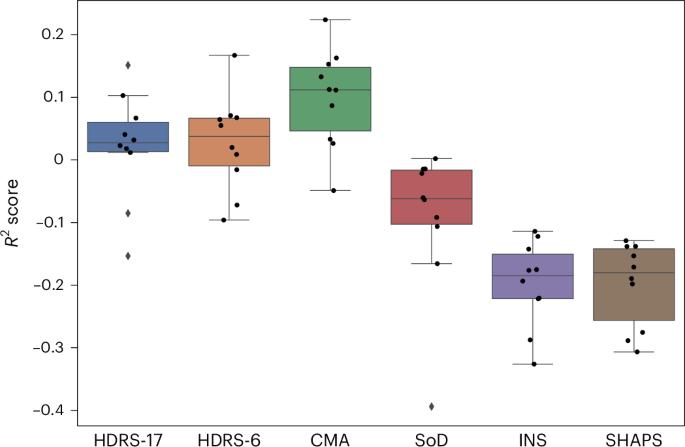Predicting dimensional antidepressant response to repetitive transcranial magnetic stimulation using pretreatment resting-state functional connectivity
IF 8.7
引用次数: 0
Abstract
Repetitive transcranial magnetic stimulation is an effective treatment for depression that modulates resting-state functional connectivity (RSFC) of depression-relevant neural circuits. So far, however, few studies have investigated whether individual treatment-related symptom changes are predictable from pretreatment RSFC. Here we use machine learning to predict dimensional changes in depressive symptoms using pretreatment RSFC. We hypothesized that changes in dimensional depressive symptoms would be predicted more accurately than scale total scores. Patients with depression (n = 26) underwent pretreatment RSFC magnetic resonance imaging. Depressive symptoms were assessed with the 17-item Hamilton Depression Rating Scale (HDRS-17). Random forest regression models were trained to predict treatment-related symptom changes captured by the HDRS-17, HDRS-6 and three previously identified HDRS subscales: core mood and anhedonia (CMA), somatic disturbances and insomnia. Changes along the CMA, HDRS-17 and HDRS-6 were predicted significantly above chance, with 9%, 2% and 2% of out-of-sample outcome variance explained, respectively (all P values <0.001). CMA changes were predicted more accurately than the HDRS-17 (P < 0.05). Higher baseline global connectivity (GC) of default mode network subregions and the somatomotor network predicted poorer outcomes, while higher GC of the right dorsal attention frontoparietal control and visual networks predicted reduced CMA symptoms. HDRS-17 and HDRS-6 changes were predicted with similar GC patterns. These results suggest that RSFC spanning the default mode, somatomotor, dorsal attention, frontoparietal control and visual network subregions predict dimensional changes with significantly greater accuracy than syndromal changes after repetitive transcranial magnetic stimulation. These findings highlight the need to assess more granular clinical dimensions in therapeutic studies and echo earlier studies supporting that dimensional outcomes improve model accuracy. This study investigates the predictability of treatment-related symptom changes in depression using pretreatment resting-state functional connectivity. Machine learning models demonstrated significant accuracy in forecasting dimensional symptom changes, emphasizing the importance of assessing granular clinical dimensions for improved therapeutic outcomes.

使用预处理静息状态功能连通性预测重复经颅磁刺激的维度抗抑郁反应
重复经颅磁刺激可调节抑郁症相关神经回路的静息状态功能连接(RSFC),是一种有效的抑郁症治疗方法。然而,到目前为止,很少有研究调查预处理RSFC是否可以预测个体治疗相关症状的改变。在这里,我们使用机器学习来预测使用预处理RSFC的抑郁症状的维度变化。我们假设维度抑郁症状的变化比量表总分更能准确地预测。抑郁症患者(n = 26)行预处理RSFC磁共振成像。采用17项汉密尔顿抑郁评定量表(HDRS-17)评定抑郁症状。训练随机森林回归模型来预测HDRS-17、HDRS-6和先前确定的三个HDRS子量表:核心情绪和快感缺乏(CMA)、躯体障碍和失眠所捕获的与治疗相关的症状变化。沿CMA, HDRS-17和HDRS-6的变化预测显著高于机会,分别解释了9%,2%和2%的样本外结果方差(所有P值<;0.001)。CMA变化预测比HDRS-17更准确(P < 0.05)。较高的基线全局连通性(GC)的默认模式网络子区域和躯体运动网络预测较差的结果,而较高的GC的右背注意额顶叶控制和视觉网络预测减少CMA症状。HDRS-17和HDRS-6的变化预测具有相似的GC模式。这些结果表明,重复性经颅磁刺激后,RSFC跨越默认模式、躯体运动、背侧注意、额顶叶控制和视觉网络亚区预测维度变化的准确性显著高于综合征变化。这些发现强调了在治疗研究中评估更细粒度的临床维度的必要性,并呼应了早期支持维度结果提高模型准确性的研究。本研究利用预处理静息状态功能连通性探讨抑郁症治疗相关症状变化的可预测性。机器学习模型在预测维度症状变化方面表现出显著的准确性,强调了评估颗粒临床维度对改善治疗结果的重要性。
本文章由计算机程序翻译,如有差异,请以英文原文为准。
求助全文
约1分钟内获得全文
求助全文

 求助内容:
求助内容: 应助结果提醒方式:
应助结果提醒方式:


